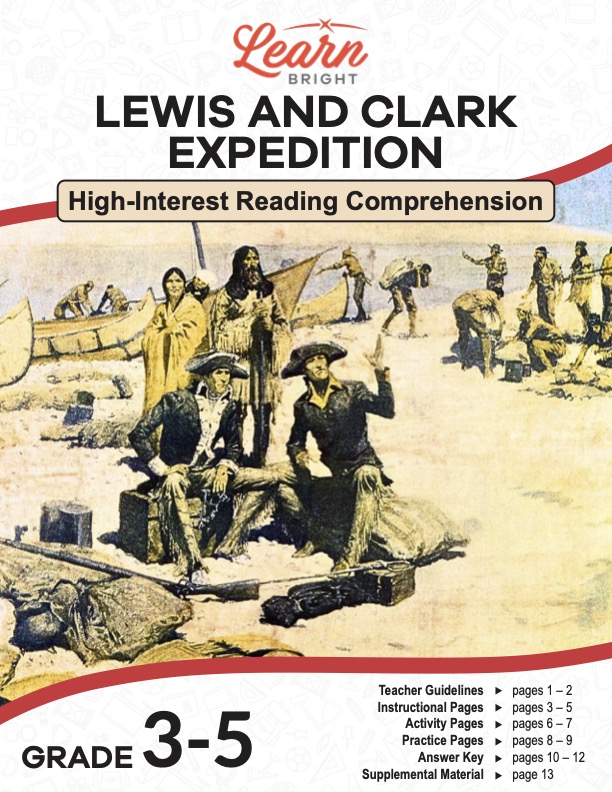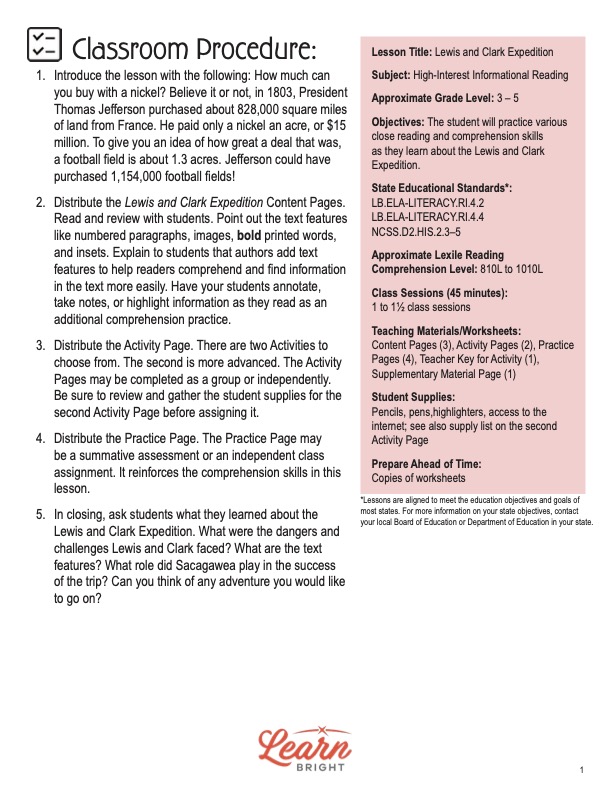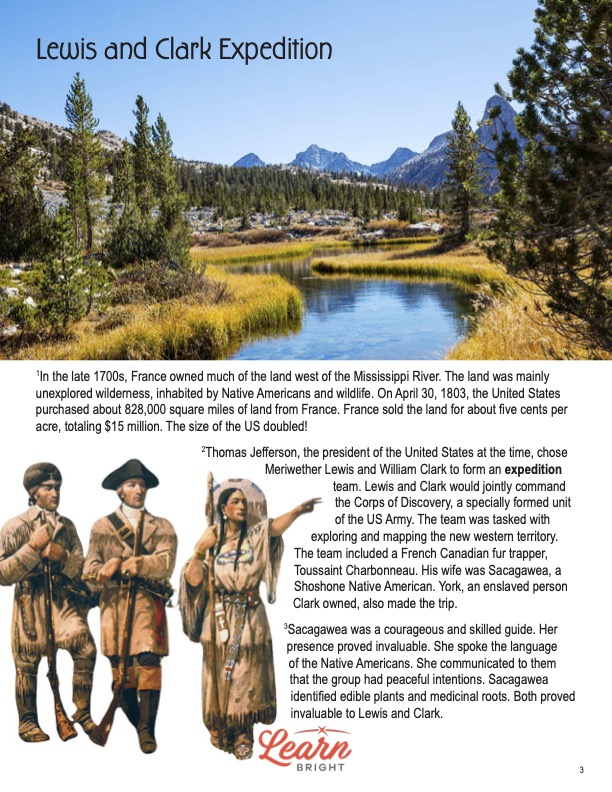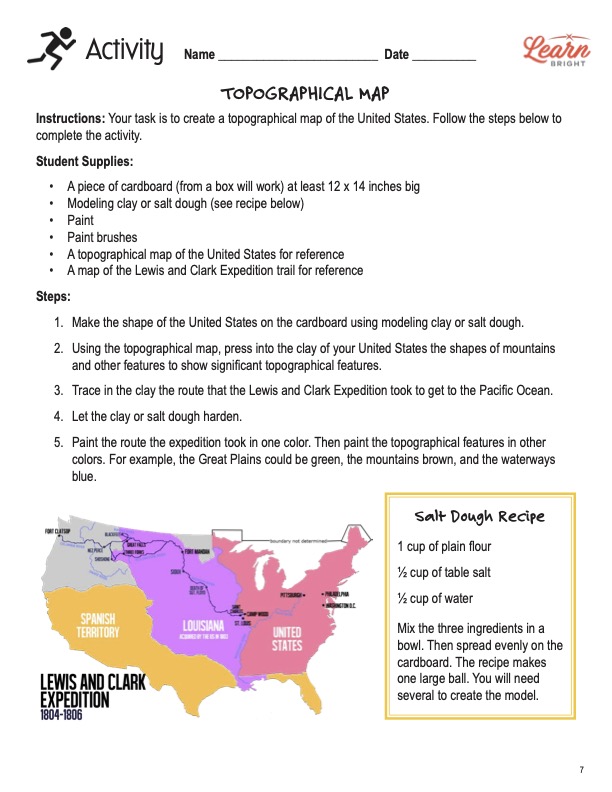Description
What our Lewis and Clark Expedition lesson plan includes
Lesson Objectives and Overview: Lewis and Clark Expedition is a high-interest reading comprehension lesson plan. As such, students will practice various close reading and comprehension skills as they learn about the Lewis and Clark Expedition. This lesson is for students in 3rd grade, 4th grade, and 5th grade.
Classroom Procedure
Every lesson plan provides you with a classroom procedure page that outlines a step-by-step guide to follow. You do not have to follow the guide exactly. The guide helps you organize the lesson and details when to hand out worksheets. It also lists information in the yellow box that you might find useful. You will find the lesson objectives, state standards, and number of class sessions the lesson should take to complete in this area. In addition, it describes the supplies you will need as well as what and how you need to prepare beforehand. The activity lists several supplies you will need to complete the assignment.
Teacher Notes
The paragraph on this page gives you a little more information on the lesson overall and describes what you may want to focus your teaching on. It explains that you can teach this lesson in a whole-class setting or as an independent, small-group activity. The blank lines are available for you to write out any thoughts or ideas you have as you prepare.
LEWIS AND CLARK EXPEDITION LESSON PLAN CONTENT PAGES
Louisiana Purchase and the Expedition
The Lewis and Clark Expedition lesson plan contains three content pages. In the late 1700s, France owned much of the land west of the Mississippi River. The land was mainly unexplored wilderness, inhabited by Native Americans and wildlife. On April 30, 1803, the United States purchased about 828,000 square miles of land from France. France sold the land for about five cents per acre, totaling $15 million. The size of the US doubled!
Thomas Jefferson, the president of the United States at the time, chose Meriwether Lewis and William Clark to form an expedition team. Lewis and Clark would jointly command the Corps of Discovery, a specially formed unit of the US Army. The team was tasked with exploring and mapping the new western territory. The team included a French Canadian fur trapper, Toussaint Charbonneau. His wife was Sacagawea, a Shoshone Native American. York, an enslaved person Clark owned, also made the trip.
Sacagawea was a courageous and skilled guide. Her presence proved invaluable. She spoke the language of the Native Americans. She communicated to them that the group had peaceful intentions. Sacagawea identified edible plants and medicinal roots. Both proved invaluable to Lewis and Clark.
The Expedition Begins
Lewis and Clark officially began the expedition on May 21, 1804, when the leaders and the Corps of Discovery left their camp near St. Louis, Missouri. They traveled up the Missouri River on a large flatboat and two smaller dugout boats called pirogues.
The expedition faced incredible dangers. Unpredictable weather, unfamiliar wildlife, river rapids, and starvation were a constant threat. They encountered several Native American tribes along the way. At least twice they encountered tribes of the Lakota nation, who they called the Sioux. The first meeting was peaceful, but the second nearly led to a fight. The tribe demanded a boat payment before they allowed them to pass. The corps refused, but in the end, the two worked out their differences peacefully.
In December of 1804, the journey continued upriver. They stopped at the villages of a group of Native Americans to resupply. While waiting for the winter to end, they built Fort Mandan, named after the Mandan tribe. While there, Lewis and Clark sent their first report back to President Jefferson. They sent back topographical maps and details of the journey. The report chronicled 108 new plant species and 68 types of minerals! The expedition left Fort Mandan in early spring when the weather was more favorable.
Obstacles in the Journey
In May 1805, they came to a fork in the Missouri River. Not sure which direction to travel, Lewis and Clark asked the team to vote. Thirty-one people voted for the right fork. Only two—Lewis and Clark—voted for the left. The expedition was split into two groups, one taking the right fork, and one taking the left fork. Both groups eventually found the Missouri River and were reunited in June.
While it may sound easy to float on the river’s currents, that was not always possible. The pirogues sometimes encountered shallow water or sandbars, or the river narrowed. When this happened, the men had to carry the boats and supplies over land. Even empty pirogues weighed between 3,500 and 5,000 pounds!
In August of 1805, they arrived at the Continental Divide. The explorers switched to horseback and foot, with no more rivers to travel. The team began the next leg of the expedition at Lemhi Pass on the Montana-Idaho border. The men carried all the supplies over the steep and treacherous terrain. Their backpacks weighed anywhere from 50 to 75 pounds. Once they cleared the Continental Divide, the expedition could continue by river once more.
The expedition funneled down the Rocky Mountains and paddled canoes along the Clearwater Snake River. They ended up on the Columbia River in present-day Portland, Oregon. In December, Lewis and Clark’s expedition reached the Pacific Ocean. It was winter, and they decided to wait for more favorable weather before departing for home. They built Fort Clatsop on the south side of the Columbia River. In the journals of Lewis and Clark, the weather and the fort are described as miserable. Their hope of returning home sustained them through the harsh conditions.
Journey Home
On March 23, 1806, their journey home finally began. The weary group separated briefly so Lewis could explore a tributary of the Missouri River, the Marias River. The corps reunited at the convergence of the Yellowstone and Missouri Rivers. Then, on September 23, it was on to St. Louis where their incredible adventure began! Lewis returned to Washington, DC, to give his final report to President Jefferson in late December of that year, and Clark in January of 1807. Both were hailed as American heroes.
Amazingly, though the journey was incredibly treacherous and dangerous, the only reported death among the expedition was one soldier who died from appendicitis. The journey took two years, and the team traveled more than 8,000 miles total. Afterward, Lewis was appointed governor of the Upper Louisiana Territory.
Clark worked for Lewis until he was appointed governor of the Missouri Territory. He also honored a promise he had made to Sacagawea to take care of her children in the event of her death. In August of 1813, he adopted her two children. And during an interview in 1832, he said he had freed York about 10 years after the expedition.
LEWIS AND CLARK EXPEDITION LESSON PLAN WORKSHEETS
The Lewis and Clark Expedition lesson plan includes three worksheets: two activity worksheets and a practice worksheet. Each one will help students solidify their grasp of the material they learned throughout the lesson. You can refer to the classroom procedure guidelines to know when to hand out each worksheet.
EXPEDITION ACCOMPLISHMENTS ACTIVITY WORKSHEET
For the first activity, students will discover whether or not Lewis and Clark accomplished the tasks that President Jefferson wanted them to. The chart shows six tasks. Students may need to research online to find the answers if they can’t find them in the content pages. They will write their answers in the right-hand column.
TOPOGRAPHICAL MAP ACTIVITY WORKSHEET
This activity requires students to get their hands dirty! Using the supplies you provide, students will build topographical maps of the United States. They will use modeling clay or salt dough to build the shape of the US. Once it dries, they will paint their maps. They should use one color for the path Lewis and Clark took. Then they will use different colors for the various topographical features. For instance, they could paint the waterways blue and the Great Plains green.
LEWIS AND CLARK EXPEDITION PRACTICE WORKSHEET
The practice worksheet requires students to answer a series of 10 questions. These questions all relate to the content pages, so students will need to refer to them often for the answers. In addition, each question provides which reading tool the question corresponds to, such as text feature, vocabulary, or comprehension.
Worksheet Answer Keys
At the end of the lesson plan document is an answer key for the practice worksheet. (There is also an answer key for the first activity for your reference.) The correct answers are all in red to make it easier for you to compare them with students’ responses. If you choose to administer the lesson pages to your students via PDF, you will need to save a new file that omits these pages. Otherwise, you can simply print out the applicable pages and keep these as reference for yourself when grading assignments.









